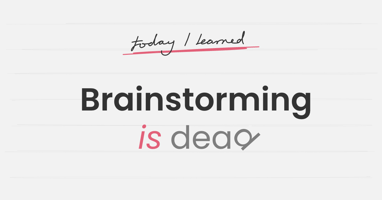Organizations led by strong innovation and R&D teams focused on strategic initiatives stay ahead of the competition. This focus on strategy gets the right products to market at the right time, helping claim first mover advantage and maximize revenue and profit potential.
When a company has a culture of R&D, great ideas bubble to the top and the team keeps working on the next best thing.
Forbes Technology Council members – CTOs, CIOs and executives who offer first hand insight on tech and business – weighed in with 16 tips for helping promote a culture of research and development (R&D) for your team.
Here are six tips to promote a successful and effective R&D culture within your organization:
1. Clearly define your goals and metrics
Typically, strategy is developed at the executive level. To increase the changes of the strategy being realized, it needs to be communicated down to the people who execute on it. Like other groups, R&D teams require a line of site to what the strategy is and how their work supports it.
Executive leadership can start by setting clear goals and outlining what success looks like. Once the organization is aligned around the goals, R&D needs a mechanism to communicate progress from the bottom up. The R&D team also needs to leverage the right tools to help accomplish set goals.
Performance metrics based on accurate, real-time data collected in the course of day-to-day work and made visible in an easy-to-consume visual format helps R&D teams to see the strategic contribution of their work. It helps keep individuals on the team engaged, motivated, and focused on what really matters to the company. It also makes it much easier for leadership to see progress.
2. Balance focus and exploration
It is critical to get the balance right between focus and idea exploration. Exploring ideas is essential to discovering new-to-market or new-to-world innovations. Exploring ideas and concepts that are closely related – or, conversely, exploring seemingly unrelated concepts – can lead to those “eureka!” moments. But there is a danger of spending too much time exploring and not enough resources on developing top ideas.
On the flipside, if there is too narrow of a tunnel of focus, opportunities staring you in the face may be missed. And there is risk in focusing too much on your core, especially in today's disruptive business world. There needs to be a healthy balance between idea exploration and focusing on selected core idea(s).
3. Give your team room to experiment
Strategic goals are necessary. But talented people need room to explore, be creative, and play outside the sandbox with their ideas to develop solutions that meet customer needs and solve problems.
There are a wide variety of ways to give talented people room to ideate, innovate and maximize their creativity. Above all, the company culture should empower people to experiment and to contribute their best. Failure should always be an option – as long as it is a learning experience.
Systems and tools that encourage openness and real-time collaboration (while still protecting sensitive intellectual property) can help, especially when they surface historical learnings and facilitate knowledge discovery (example: new applications using existing technology). Idea campaigns, innovation labs or idea marathon weeks can also help spur innovation in unlikely ways.
4. Involve R&D in Ggo-to-market discussions
Don't let a disconnect between the Go-to-Market (GTM) team and the R&D team(s) result in wasted efforts. This disconnect can negatively impact the potential of the innovation, waste time and money on innovation failures, and demotivate everyone involved.
By “marrying” the teams, R&D can tell GTM what they can do, and GTM can inform when and where they should do it, setting up the innovation to seize the biggest market share.
Connecting these cross-functional teams can be difficult, especially in a large enterprise. An automated Enterprise Innovation Management (EIM) software system can greatly increase the impact of shared insights and reduce the time required for cross-functional team members to provide input on shared deliverables. It can also streamline review and approval processes, helping the two teams to accelerate an innovation to market.
5. Focus on business awareness and problem solving
Aligning the technical people developing innovative technologies with customer demand and business direction can be challenging.
Keeping the end-consumer in mind — their changing needs, their problems — and how you can help will ensure your innovations are in demand. Embedding this mindset into the day-to-day life of R&D teams will help the right ideas, inventions, and innovations bubble to the top for maximum market impact.
6. Empower people
Creating a culture that focuses on innovation aligns the right teams and strategies, enabling cross-functional communication, decision making and knowledge sharing. It empowers people to do what they do best is possible. It just takes some planning, structure, the right tools and a lot of creativity.
With full transparency to strategic direction, R&D and business value, product and portfolio decisions, and innovation plans, Accolade connects the organization and empowers all teams to be strategic and agile when responding to marketplace change and to delivering new products. Accolade is your complete enterprise innovation management product.
Learn more about building a culture for innovation with these additional resources:
- Listen to building a culture of innovation with Cris Beswick part one and part two
- Download the Innovation Blockers Report
- Read how to how to choose the right enterprise innovation management system







